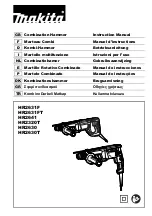
9
This tool has a reversing switch to change the direction
of rotation. Move the reversing switch lever to the
position (A side) for clockwise rotation or the
position (B side) for counterclockwise rotation.
Changing the quick change chuck for SDS-plus
For Model HR2631FT, HR2320T, HR2630T
The quick change chuck for SDS-plus can be easily
exchanged for the quick change drill chuck.
Removing the quick change chuck for SDS-plus
(Fig. 6)
CAUTION:
• Before removing the quick change chuck for SDS-plus,
always remove the bit.
Grasp the change cover of the quick change chuck for
SDS-plus and turn in the direction of the arrow until the
change cover line moves from the
symbol to the
symbol. Pull forcefully in the direction of the arrow.
Attaching the quick change drill chuck (Fig. 7)
Check the line of the quick change drill chuck shows the
symbol. Grasp the change cover of the quick change
drill chuck and set the line to the
symbol.
Place the quick change drill chuck on the spindle of the
tool.
Grasp the change cover of the quick change drill chuck
and turn the change cover line to the
symbol until a
click can clearly be heard.
Selecting action mode
CAUTION:
• Do not rotate the action mode changing knob when the
tool is running. The tool will be damaged.
• To avoid rapid wear on the mode change mechanism,
be sure that the action mode changing knob is always
positively located in one of the three action mode
positions.
Rotation with hammering (Fig. 8)
For drilling in concrete, masonry, etc., rotate the action
mode changing knob to the
symbol. Use a tungsten-
carbide tipped bit.
Rotation only (Fig. 9)
For drilling in wood, metal or plastic materials, rotate the
action mode changing knob to the
m
symbol. Use a twist
drill bit or wood bit.
Hammering only (Fig. 10)
For chipping, scaling or demolition operations, rotate the
action mode changing knob to the
g
symbol. Use a bull
point, cold chisel, scaling chisel, etc.
Torque limiter
CAUTION:
• As soon as the torque limiter actuates, switch off the
tool immediately. This will help prevent premature wear
of the tool.
• Bits such as hole saw, which tend to pinch or catch
easily in the hole, are not appropriate for this tool. This
is because they will cause the torque limiter to actuate
too frequently.
The torque limiter will actuate when a certain torque level
is reached. The motor will disengage from the output
shaft. When this happens, the bit will stop turning.
Hook (Fig. 11)
For Model HR2641
CAUTION:
• Never hook the tool at high location or on potentially
unstable surface.
The hook is convenient for hanging the tool temporarily.
To use the hook, simply lift up hook until it snaps into the
open position.
When not in use, always lower hook until it snaps into the
closed position.
ASSEMBLY
CAUTION:
• Always be sure that the tool is switched off and
unplugged before carrying out any work on the tool.
Side grip (auxiliary handle) (Fig. 12)
CAUTION:
• Always use the side grip to ensure operating safety.
Install the side grip so that the protrusions on the grip fit
in between the grooves on the tool barrel. Then tighten
the grip by turning clockwise at the desired position. It
may be swung 360° so as to be secured at any position.
Bit grease
Coat the bit shank head beforehand with a small amount
of bit grease (about 0.5 – 1 g).
This chuck lubrication assures smooth action and longer
service life.
Installing or removing the bit
Clean the bit shank and apply bit grease before installing
the bit.
(Fig. 13)
Insert the bit into the tool. Turn the bit and push it in until
it engages.
(Fig. 14)
After installing, always make sure that the bit is securely
held in place by trying to pull it out.
To remove the bit, pull the chuck cover down all the way
and pull the bit out.
(Fig. 15)
Bit angle (when chipping, scaling or demolishing)
The bit can be secured at the desired angle. To change
the bit angle, rotate the action mode changing knob to
the
O
symbol. Turn the bit to the desired angle.
(Fig. 16)
Rotate the action mode changing knob to the
g
symbol.
(Fig. 17)
Then make sure that the bit is securely held in place by
turning it slightly.
Depth gauge
The depth gauge is convenient for drilling holes of
uniform depth.
(Fig. 18)
Press the lock button on the grip base in the direction of
arrow shown in the figure and with the lock button being
pressed insert the depth gauge into the hex. hole in the
grip base.
(Fig. 19)
At this time, the depth gauge needs to be inserted so that
its toothed side is directed to the toothed side of hex hole
marking on the grip base as shown in the figure.
(Fig. 20)
Adjust the depth gauge to the desired depth by moving it
back and forth while pressing the lock button. After the
adjustment, release the lock button to lock the depth
gauge.
(Fig. 21)
Содержание HR2630T
Страница 6: ...6 33 34 35 36 37 38 35 36 5 6 7 015357 015358 015339 015363 015340 015359 7 9 6 8 9 37 38 25 ...
Страница 74: ...74 ...
Страница 75: ...75 ...










































